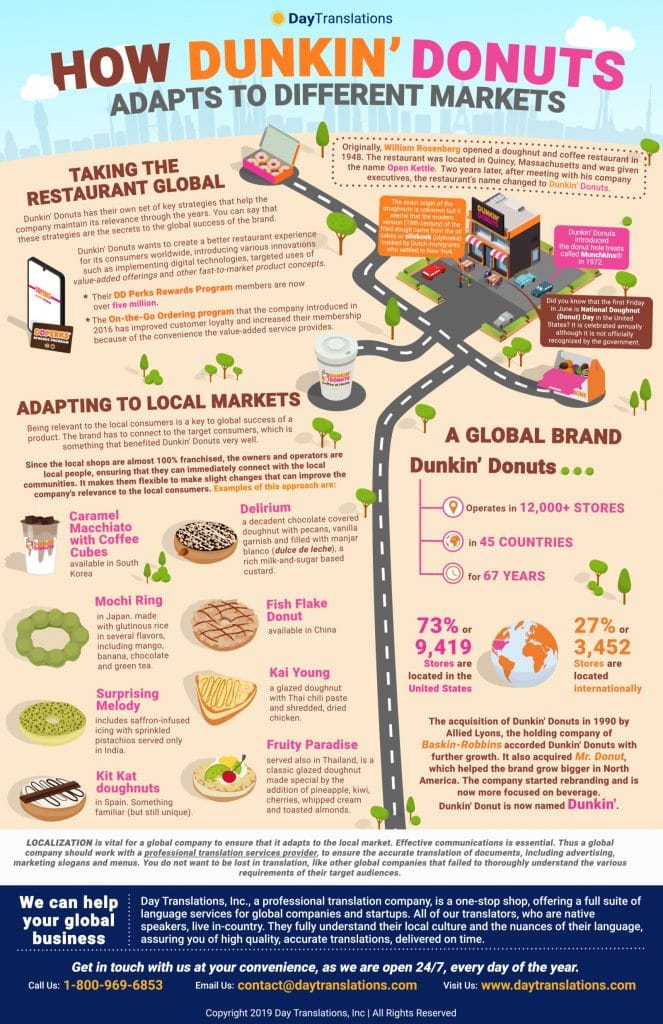From its humble beginnings, donuts or doughnuts have become a favorite snack, and Dunkin’ Donuts is one of the institutions that made the snack food popular on a global scale.
The exact origin of the doughnuts is unknown but it seems that the modern version (19th century) of the fried dough came from the oil cakes or oliekoek (olykoeks) cooked by Dutch immigrants who settled in New York, which was previously named New Amsterdam. The dough was fried in pork fat and since the center of the dough did not cook as quickly as the outside, the centers were filled with things that could be eaten raw such as nuts and fruits. Paul R. Mullins, an anthropologist, said that the origin of the doughnuts could go as far back as 1669, based on an olie-koecken recipe.
Many believe that the name “doughnut” came from the fact that nuts are placed inside the dough ball, although the veracity of this statement is not confirmed. The doughnut shape with the hole in the center is credited to American ship captain Hansen Gregory. It is said that while cooking in 1834, he punched a hole in the center of the dough ball to ensure that the entire cake would cook evenly. He later taught his mother to do the same, and as they say, the rest is history.
Doughnut or donut?
Which spelling should you use? Many are confused by how the term is spelled. Some use doughnut while others use donut. The approved spelling in the dictionary is doughnut. The other spelling variant is an American invention. Donut first appeared in print in the 1800s but only caught on around the middle of the 20th century. While the term donut became popular because of Dunkin’ Donuts, writers, especially those who are from Britain, prefer to use the standard spelling. The AP Style Book also recommends using doughnut.
Did you know that the first Friday in June is National Doughnut (Donut) Day in the United States? It is celebrated annually although it is not officially recognized by the government. It started from the 1938 campaign of the Salvation Army volunteers to serve doughnuts to the soldiers during World War I.
Early beginnings of Dunkin’ Donuts
Originally, William Rosenberg opened a doughnut and coffee restaurant in 1948. The restaurant was located in Quincy, Massachusetts and was given the name Open Kettle. At that time, he sold the premium cup of coffee for 10 cents while a serving of doughnut cost five cents.
Two years later, after meeting with his company executives, the restaurant’s name changed to Dunkin’ Donuts. Rosenberg’s objective was to produce and serve the most delicious and freshest donuts and coffee courteously and quickly in modern stores that are well-merchandized.
The first Dunkin’ Donuts franchise opened in 1955. By 1965, 100 shops were opened. Dunkin’ Donuts then started introducing innovations and changes in the menu after it reached the 100-store milestone. It introduced the donut hole treats called Munchkins® in 1972. The company began expanding its menu so their stores could serve consumers with a variety of food throughout the day.
The coffee served by Dunkin’ Donuts became very popular among consumers. Aside from regular coffee, Dunkin’ Donuts offers flavored coffee such as French Vanilla and Hazelnut. They also have seasonal coffee flavors, with Pumpkin being a regular favorite. Aside from coffee and donuts, Dunkin’ also offers sandwiches, various bakery products and several hot and cold beverages.
Taking the restaurant global
Brand longevity is something that most enterprises desire. Some are not able to thrive because it is difficult to survive the fluctuations in various trends, the shifts in values and changes in consumer preferences. Dunkin’ Donuts is a very good example of a company that is able to sustain its brands for a long time. In its 67 years of operation, it has opened over 12,000 stores in 45 countries and the company does not show any sign of stopping. It continues to innovate and create strategic partnerships to make Dunkin’ Donuts a truly global brand.
Secrets to the brand’s success
Dunkin’ Donuts has their own set of key strategies that help the company maintain its relevance through the years. You can say that these strategies are the secrets to the global success of the brand.
Follow the basics but improve on them
The company focuses on raising the bar on the variety and quality of the food and beverage items that they serve at their restaurants. Dunkin’ Donuts has a culinary innovation team whose task is to explore new items to add to the restaurants’ menu. They are looking for and creating more options to offer their customers. They are also developing coffee innovation, because the coffee that Dunkin’ Donuts serve remains a best-seller through the years.
Dunkin’ Donuts wants to create a better restaurant experience for its consumers worldwide, introducing various innovations such as implementing digital technologies, targeted uses of value-added offerings and other fast-to-market product concepts.
The company keeps up with the times, knowing that many of their loyal customers use digital and mobile technology. They have to make the brand different from their competitors. Their DD Perks Rewards Program members are now over five million.
The On-the-Go Ordering program that the company introduced in 2016 has improved customer loyalty and increased their membership because of the convenience the value-added service provides.
Local relevance
Being relevant to the local consumers is a key to global success of a product. They brand has to connect to the target consumers, which is something that benefited Dunkin’ Donuts very well. Since the local shops are almost 100% franchised, the owners and operators are local people, ensuring that they can immediately connect with the local communities. This gives them an edge over other foreign-owned brands. It also makes them flexible to make slight changes that can improve the company’s relevance to the local consumers. Examples of this approach are the Turkish Coffee that is served in outlets in the Republic of Georgia and the Caramel Macchiato with Coffee Cubes that is available in South Korea. Other local offerings are available through the DD Perks Rewards program of the company.
The acquisition of Dunkin’ Donuts in 1990 by Allied Lyons, the holding company of Baskin-Robbins accorded Dunkin’ Donuts with further growth. It also acquired Mr. Donut, which helped the brand grow bigger in North America. The company started rebranding and is now more focused on beverage. Dunkin’ Donut is now named Dunkin’.
Despite the change in name, the strategic partnerships the company formed have helped its growth locally and globally. Dunkin’ Donuts is a partner of many college and professional football teams, basketball teams and NHL teams, too. The partnerships create a major buzz because of the personalities, teams and popular athletes that it features in its promotional campaigns.
Tying-in their sports promotions with their DD Perks Membership program match the fast-paced lifestyle of the sports personalities and fans.
Further localization of the brand
To sustain the products’ relevance to their varied customers, the company has to adapt the products to the local markets, which is further enhanced by the presence of Baskin-Robbins in countries where several Dunkin’ Donuts restaurants operate. To gain local consumer patronage and loyalty, suiting the local consumers’ taste is imperative.
For example, in Peru, Dunkin’ Donuts serves Delirium, a decadent chocolate covered doughnut with pecans, vanilla garnish and filled with manjar blanco (dulce de leche), a rich milk-and-sugar based custard.
In some Asian countries you’ll find Asian-inspired doughnuts. In South Korea they have rice doughnuts as well as charcoal doughnuts. Because the Koreans customers are fond of spices, the restaurant also offers kimchi-stuffed savory doughnut and jalapeno sausage pie doughnut.
In China you can find fish flake doughnuts while in Thailand, mango doughnuts are available. Thais are also able to buy Fruity Paradise, which is a classic glazed doughnut made special by the addition of pineapple, kiwi, cherries, whipped cream and toasted almonds. Another special creation is Kai Young, also a glazed doughnut with Thai chili paste and shredded, dried chicken.
If you’re a chocolate lover, Dunkin’ Donuts restaurants in Colombia offer triple chocolate doughnuts. In India, they sell saffron-infused icing on Surprising Melody doughnut together with a sprinkling of pistachios.
Rose cream doughnuts are sold in Lebanon and in Indonesia, they offer black cheese doughnut. When you’re traveling around Netherlands, try the stroopwafel doughnut or if you want something familiar (but still unique), have some Kit Kat doughnuts in Spain.
You can only find the Mochi Ring doughnut in Japan. It is made with glutinous rice in several flavors, including mango, banana, chocolate and green tea.
But whichever country you’re in, you’ll be able to find Boston Cream doughnuts!
A legend all over the world
The unique doughnut creations that fit the taste of local consumers not only have their own special flavor combinations; you will find that they are available in special designs as well. Doughnuts are typically sweet, but not all over the world. In China, they have a Dunkin’ Donut covered in pork floss!
Each Dunkin’ Donut market is different. Therefore, the company employs teams to do research in order for the product to adapt to local tastes – in terms of flavor and design. In some areas the company sells more beverage than doughnuts. Elsewhere, the company receives a higher revenue from the doughnuts, sandwiches and other bakery items. In other territories, the company focuses on improving their coffee sales.
Dunkin’ Donuts does not only adapt their products to their different markets. In some locations, they also incorporate local culture, like using Delft tiles in a Dunkin’ restaurant in Holland.
The company localizes its menu in different territories, presenting them in English and the translation of the menu entries. The brand name remains the same. Dunkin’ Donuts remain a global success because it is able to adapt its products and information to fit preferences of consumers in all its international markets.
Get ready for the global stage
If you want to make it in the global market, you have to make sure that you sound local while remaining global. This means translating all your accessible information in the languages spoken by your global audiences. When you’re planning to expand your business overseas, it is already de rigueur to work with a professional language services provider to take care of your translation and localization to ensure that the language along with the cultural requirements and preferences are satisfied.
Day Translations, Inc. can meet all your language services requirements. We offer a full suite of services, handled by native speaking translators who reside in-country. Our translators and subject matter experts can work with you immediately. We are open 24 hours a day, seven days a week, throughout the year. You can get in touch with us through 1-800-969-6853. Our customer representatives speak your language so you can discuss your needs with them. You can also send us an email at Contact us if you find it more convenient.
Share this Infographic On Your Site
Image Copyright: TEA / 123RF Stock Photo















Sorry, the comment form is closed at this time.